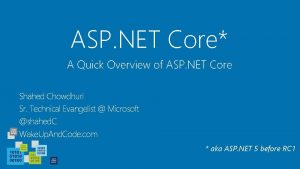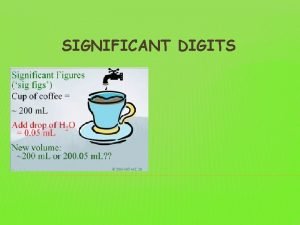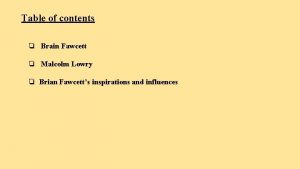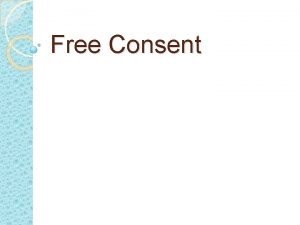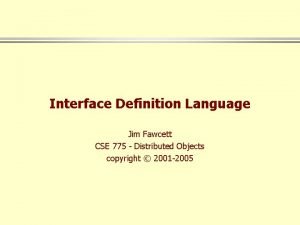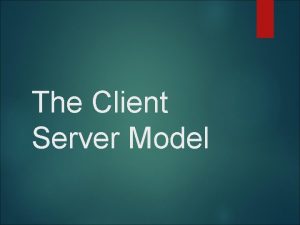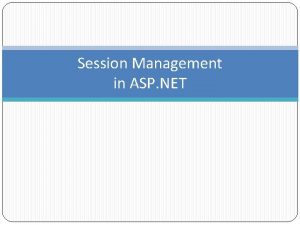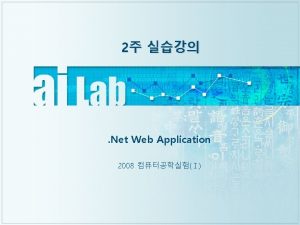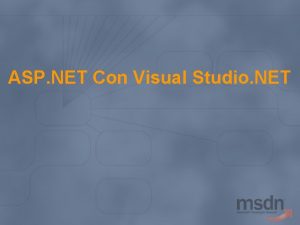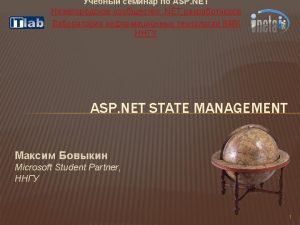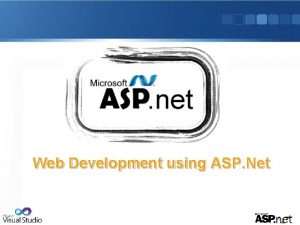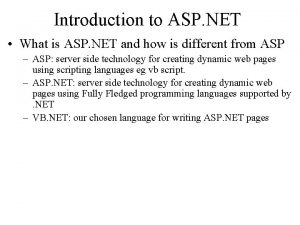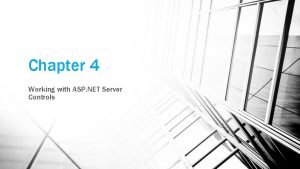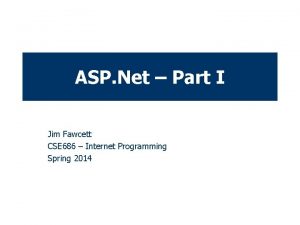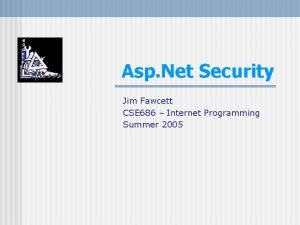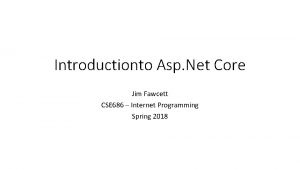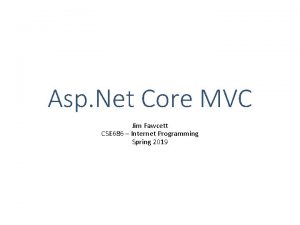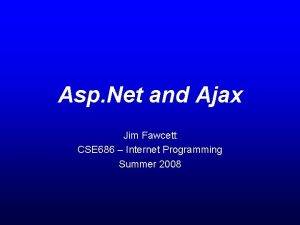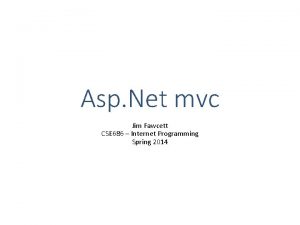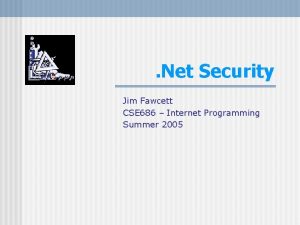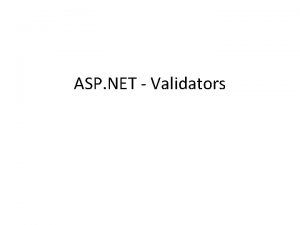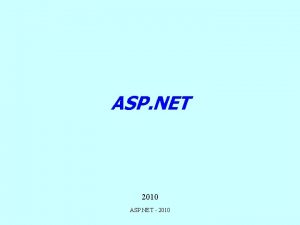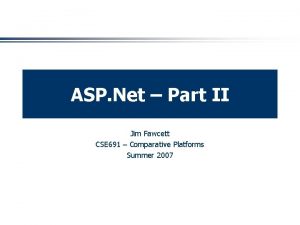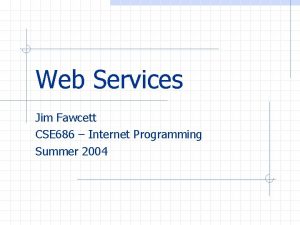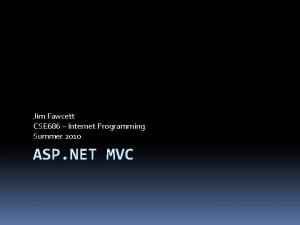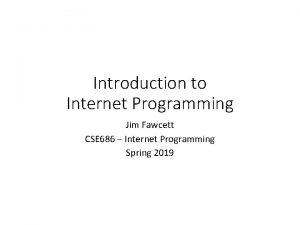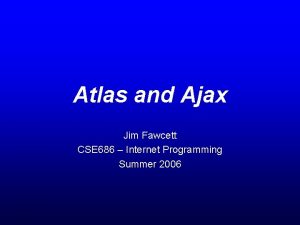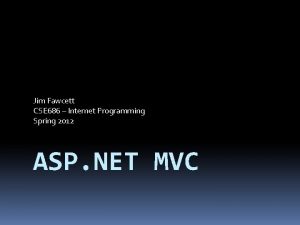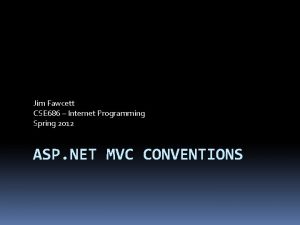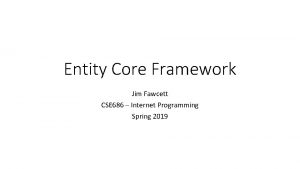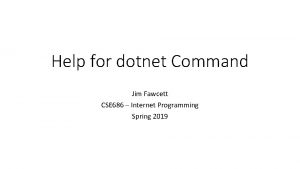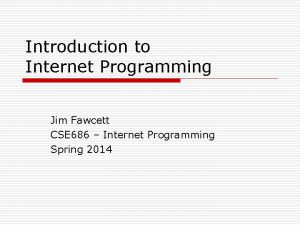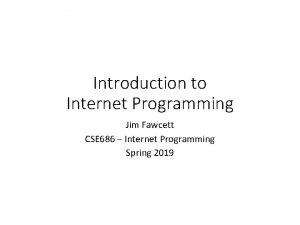ASP Net Part II Jim Fawcett CSE 686
























- Slides: 24

ASP. Net – Part II Jim Fawcett CSE 686 – Internet Programming Spring 2011

References · Pro ASP. Net 4. 0 in C# 2010, Mac. Donald, Freeman, & Szpuszta, Apress, 2010 · Programming Microsoft. Net, Jeff Prosise, Microsoft Press, 2002, Chapters 5 and 6. · Essential ASP. NET with Examples in C#, Fritz Onion, Addison. Wesley, 2003 – Several of the examples used here for state management were used with only minor modifications from this reference.

Topics · · Architecture Controls Data Binding State Management

Architecture · ASP application – – – · Process. XML. aspx. cs Web. config Page Class – – – Map. Path() Application Content. Type Context Is. Post. Back Request Response Server Session Trace User … · Process. XML_aspx – – Page_Load(Object, System. Event. Args) Button 1_Click(Object, System. Event. Args) Initialize. Component() …

Page Events · · public event Event. Handler Init; Page_Init(object, Event. Args) public event Event. Handler Load; Page_Load(object, Event. Args) public event Event. Handler Pre. Render; Page_Pre. Render(object, Event. Args) public event Event. Handler Unload; Page_Unload(object, Eventargs) · · protected virtual void On. Init(Event. Args e); protected virtual void On. Load(Event. Args e); protected virtual void On. Pre. Render(Event. Args e); protected virtual void On. Unload(Event. Args e);

ASP. Net Directives · @Page – Defines Language and Code-Behind file · @Import Namespaces – Equivalent to using directives · @Register – Registers user controls with page. Page will call render on each of its registered controls. · @Implements – Declares an interface this page implements · @Reference – Specifies a page or user control that will be compiled and linked at run-time · @Assembly – Links an assembly to the current page during compilation · Plus more – see help documentation

Page Attribures · Code. File – Specifies a path to a code-behind file for the page. Used with Inherits attribute. · Inherits – Defines a code-behind class for the page to inherit. · Auto. Event. Wireup – If true, the default, simple event handlers like Page_Load(…) are wired up automatically. · Debug – If true, code behind is compiled with debug symbols.

ASP Components · You can create library assemblies that are available to every aspx page in your application. – Compile the library dll assembly – Place it in a bin directory under the application virtual directory – It will then be implicitly referenced by any page that loads from the application directory – You can copy over the dll with an update without stopping IIS. • If you do this, the new version becomes available on the next page load.

Controls · HTML Controls – – · · – – HTML syntax runat=server attribute Derives from Html. Control Instance created at server when page is constructed asp: prefix runat=server attribute Derives from Web. Control Instance created at server when page is constructed – Richer set of methods, properties, and events than HTML Controls Examples: – – <form runat=server> <img runat=server> <input type=file runat=server> <input type=radio runat=server> Web Controls · Examples: – <asp: Text. Box id=tb 1 runat=server> – <asp: Button Text=“Submit” runat=server>

Web Control Catalog · · · · · Text. Box Label Hyper. Link Image Check. Box Radio. Button Table – matrix addresses Panel Button · · · · · List. Box Drop. Down. List Check. Box. List Radio. Button. List Repeater – HTML template Data. List – HTML template Data. Grid – no longer in toolbox by default, but can be added Calendar Validation Controls – – – Required. Field Regular. Expression Range Compare Custom

Data Related Controls · Data Controls – – – – – Grid. View Data. List Data. Set Details. View Form. View Repeater Sql. Data. Source Object. Data. Source Xml. Data. Source Site. Map. Data. Source · Validation Controls – – – Required. Field. Validator Range. Validator Regular. Expression. Validator Compare. Validator Custom. Validator

More Controls · Navigation Controls – Site. Map. Path – Menu – Tree. View · Login Controls – – – Login. View Password. Recovery Login. Status Login. Name Change. Password · Webparts – – – – Web. Part. Manager Proxy. Web. Part. Manager Web. Part. Zone Catalog. Zone Declarative. Catalog. Part Page. Catalog. Part Import. Catalog. Part Editor. Zone Appearance. Editor. Part Behavior. Editor. Part Layout. Editor. Part Property. Gride. Editor. Part Connections. Zone

User Defined Controls · User controls are stored in ascx files. · They contain an @control directive that plays the same role as the @Page directive for Web. Forms. – <%@ Control classname=“User. Control. CS” %> · In an aspx file that uses the control: – <%@ Register Tag. Prefix=“cse 686” Tag. Name=“IP” Src=“My. Control. ascx” %> – <cse 686: IP id=“my. Control 1” runat=“server” /> · A user control may contain HTML and codebehind with methods, properties, and events. · Events are declared as delegates with the event qualifier

Custom Server Controls · Custom Server Controls are stored in C# files. · A Server Control contains a C# class that defines the attributes: – – – [Bindable(true)] [Category(“Appearance”)] [Toolbox. Data(“<{0}: Nav. Bar runat=server></{0}: Nav. Bar>”)] · And a class Nav. Bar : System. Web. UI. Web. Controls. Web. Control · In an aspx file that uses the control: – <%@ Register Tag. Prefix=“cse 686” assembly=“Nav. Control” namespace=“Nav. Control %> – <cse 686: Nav. Bar id=“Nav. Bar 1” runat=“server” />

Data Binding · Data Binding provides an abstraction for loading a control with data provided by some collection. · The data is cached in the control until it is rendered on the client’s page by putting it onto the response buffer, formatted according to the control’s policy. · We have already seen an example of binding an HTML table to an XML file, in Lecture #2. · Binding is often used when an ASP application connects to a database through a Data. Reader or Data. Set.

Data Binding · Controls that Support Data Binding must expose: – a property called Data. Source – a method called Data. Bind() · The data source must provide: – IEnumerable interface · Example: Data. Set ds = new Data. Set(); ds. Read. XML(Server. Map. Path(“test. xml”); List. Box 1. Data. Source = ds; List. Box 1. Data. Text. Field = “file”; // omit if flat List. Box 1. Data. Bind();

Data Binding · Data Binding Controls – – – – Html. Select Check. Box. List Data. Grid Data. List Repeater Drop. Down. List. Box Radio. Button. List · Data Sources – – – Array. List Hash. Table Queue Sorted. List Stack String. Collection Data. View Data. Table Data. Set IData. Reader Classes that implement IEnumerable

State Management · Adding user state inherently reduces scalability. – So if you are trying to provide a resource that handles a large volume of traffic, you will want to minimize use of state. · Types of state – Application: Shared across all clients of this application – Session: Per client state persistent over page boundaries. Requires cookies or URL mangling to manage client association. – Cookie: Per client state stored on client. Clients can disable cookies. – View. State: Shared across post requests to the same page. Sent back and forth with each request.

Application State · In Global. asax: (add new item/Global Application Class) void Application_Start(object src, Event. Args e) { Data. Set ds = new Data. Set(); // populated by clients Application[“Shared. Data. Set”] = ds; } · In Application Page: private void Page_Load(object src, Event. Args e) { Data. Set ds = (Data. Set)(Application[“Shared. Data. Set”]); // client interacts with Data. Set }

Session State · By default session state is managed in the same process and application domain as the application so you can store any data in session state directly. · Session state is available as a property of both Page and Http. Context classes. · It is: – Initialized in Global. asax – Accessed in any member function of the Page. · You specify whether you want session ids managed as cookies or URL mangling in the web. config file: <configuration> <system. web> <session. State cookieless=“true” /> </system. web> </configuration>

Session State · In Global. asax: void Session_Start(object src, Event. Args e) { Data. Set ds = new Data. Set(); // populated by clients Session[“my. Data. Set”] = ds; } · In Application Page: private void Page_Load(object src, Event. Args e) { Data. Set ds = (Data. Set)(Session[“my. Data. Set”]); // client interacts with Data. Set }

Cookies · Protected void Page_Load(Object sender, Event. Args e) { int age = 0; if(Request. Cookies[“Age”] == null) Http. Cookie ac = new Http. Cookie(“Age”); ac. Value = age. Text. Box. Text; Response. Cookies. Add(ac); age = Convert. To. Int 32(age. Text. Box. Text); } else { age = Convert. To. Int 32(Request. Cookies[“Age”]. Value); } // use age }

View. State · View. State is used by ASP controls to transfer control state back and forth between server and client. · You also can use View. State to transfer application state: private void Page_Load(Object sender, Event. Args e) { Array. LIst cart = (Array. List)View. State[“Cart”]; if(cart == null) { cart = new Array. List(); View. State[“Cart”] = cart; } } // use cart with: Array. List cart = (Array. List)View. State[“Cart”]; cart… yada, yada

End of Presentation
 Classic asp to asp.net migration
Classic asp to asp.net migration Sig digs rules
Sig digs rules Margerie bonner
Margerie bonner Peek vs gurney
Peek vs gurney Brian fawcett
Brian fawcett Where was alexander hamilton born
Where was alexander hamilton born Philippa fawcett
Philippa fawcett Barry fawcett
Barry fawcett Dennis fawcett
Dennis fawcett Dr richard fawcett
Dr richard fawcett Graham fawcett
Graham fawcett Fawcett definition
Fawcett definition Barry fawcett
Barry fawcett Jonathan ruby
Jonathan ruby Imperva waf bypass xss
Imperva waf bypass xss Client server architecture in asp net
Client server architecture in asp net Asp.net session management
Asp.net session management Asp.net execution model
Asp.net execution model Asp.net agenda
Asp.net agenda Microsoft asp.net core privilege escalation (march 2018)
Microsoft asp.net core privilege escalation (march 2018) Asp net session state
Asp net session state Asp.net timeline
Asp.net timeline What is aspnet
What is aspnet Asp.net server controls
Asp.net server controls Introduction to asp.net
Introduction to asp.net
